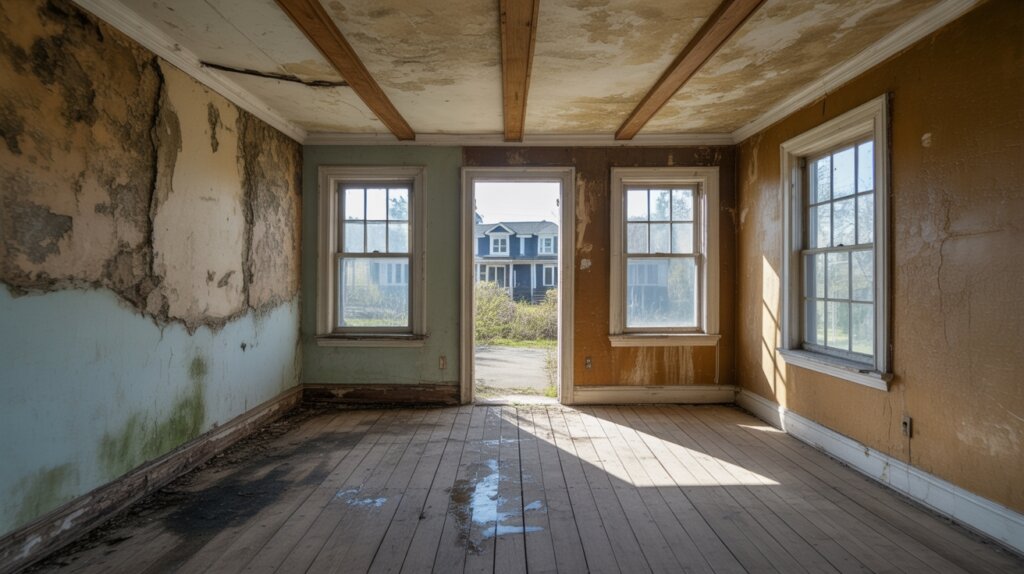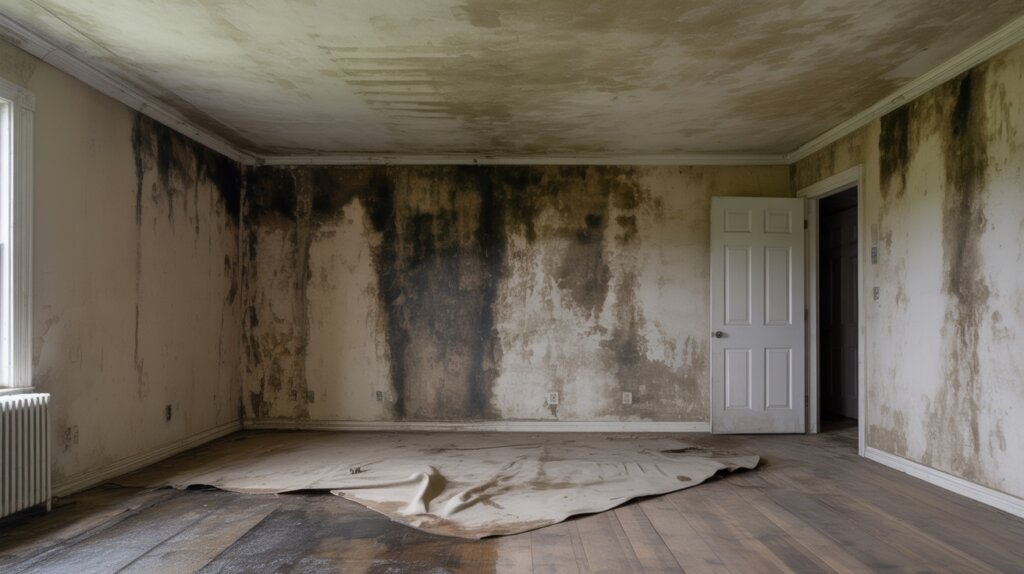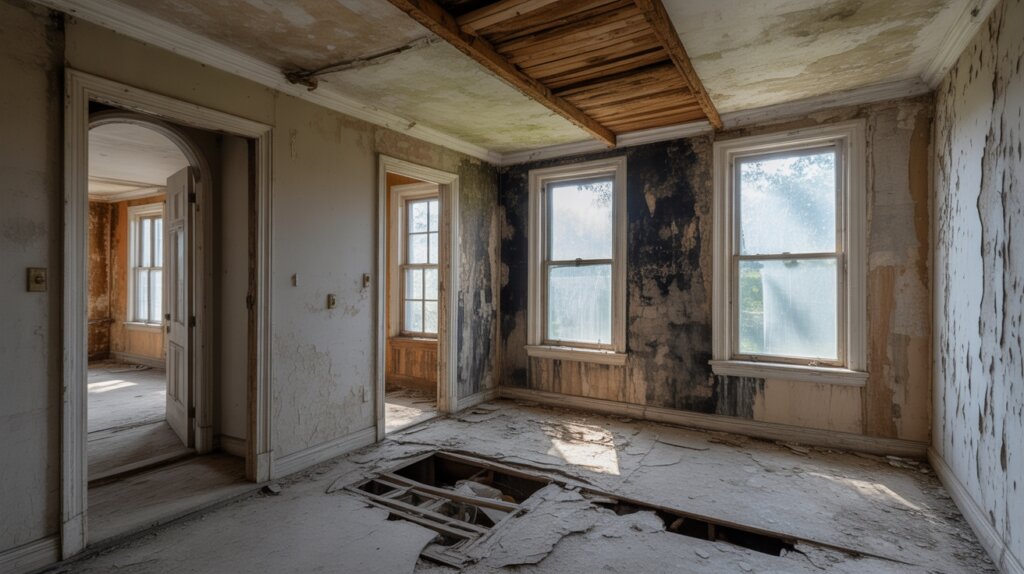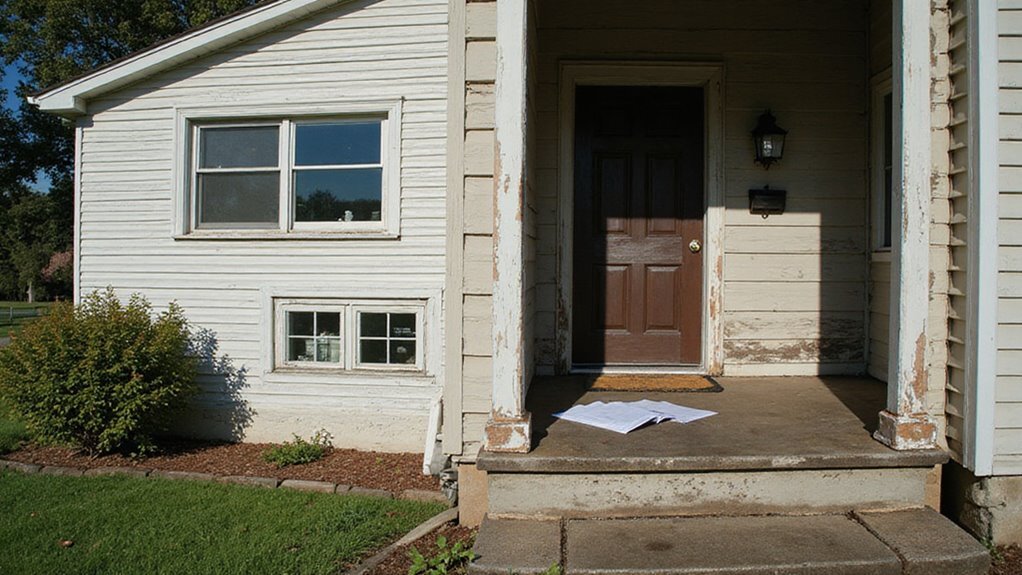Selling a house is hard enough, but mold or water damage makes it much harder. Buyers notice these issues right away. They hesitate, worry about costs, and often walk away.
Mold and water damage scare off many buyers. You may get fewer offers and much lower prices. The process takes longer and feels frustrating.
Selling a house with mold or water damage is much more complicated than a traditional sale and usually brings bigger challenges.
The good news is that you have options. You can still sell your house if you know what steps to take. This blog will guide you through the process and help you make smart choices to solve this issue.
Key Takeaways
- Homes with mold or water damage sell for lower prices and often stay on the market longer than undamaged properties.
- Disclosure of known damage is legally required, while traditional sales may have fewer regulatory hurdles.
- Damaged homes attract mainly investors or cash buyers, unlike traditional sales targeting owner-occupants.
- Financing is harder to secure for damaged properties, often requiring cash offers, unlike traditional sales with broader lender options.
- Repair costs and documentation are major negotiation points in damaged home sales, whereas traditional sales focus more on market value and features.
Disclosure Requirements and Legal Obligations

When selling a house with mold or water damage, you must tell buyers about these problems. Laws require sellers to share known issues. You cannot hide health or safety risks from buyers.
Full disclosure protects you from legal trouble later. Buyers need to know about any repairs or cleanup done. Honest sellers build trust and make the sale process easier. Being transparent about the extent of mold contamination and remediation efforts can help prevent disputes and delays.
If you provide documents showing repairs, buyers may feel more comfortable. Mold and water damage can make buyers nervous. Clear records help address their concerns.
Transparency meets your legal duties and shows responsibility. It also helps in today’s market where buyers care about environmental issues. Being open supports a smooth and fair sale. Proper documentation and inspection are essential to demonstrate due diligence and compliance.
Impact on Home Value and Marketability
Disclosing mold or water damage can lower your home’s value and make it harder to sell. Buyers often avoid homes with these problems. Many will offer less money or lose interest entirely. Revealing mold or water damage can decrease your home’s value, making it tougher to sell and discouraging potential buyers.
If your home has mold or water damage, it may attract fewer buyers. Homes with these issues usually stay on the market longer. Buyers may also demand repairs or price reductions. Addressing water damage promptly can prevent ongoing issues like mold growth and structural weakening, which further impact foundation stability and overall property value.
Homes without mold or water damage sell faster and at higher prices. Sellers have more control during negotiations if there are no hidden problems. Good curb appeal does not make up for known damage.
If you address mold or water damage early, you can improve your home’s value and marketability. Honest disclosure is important for a smooth sale. Properly managing and repairing water issues can also prevent future costly repairs and protect home integrity.
Inspection and Appraisal Differences

Inspections and appraisals are different when mold or water damage is present. Inspectors look for hidden problems like moisture or structural damage. Appraisers consider these issues when valuing your home. Recognizing the as-is condition is essential for setting realistic expectations about the property’s value and potential costs.
If mold is found, inspectors may call for more tests. These can include special checks for air quality or unseen mold. The goal is to find all possible risks. Proper assessment of property condition is crucial for understanding the full scope of damage and necessary repairs. Expect higher costs and longer timelines if damage is found. Expert advice can help you handle the process. Being prepared makes the process smoother.
Attracting Potential Buyers
You can still find buyers even if your property has mold or water damage. Some buyers are willing to take on repairs if the price is right. These buyers often include investors and contractors who look for such opportunities.
If your property has issues, focus on its best features. You should mention solid structure, recent upgrades, or a good layout. These strengths can help balance out concerns about damage.
Always be open about any mold or water problems. Detailed disclosures help build trust with buyers. Honesty may also reduce worries about hidden issues.
If you want to attract attention, price the home according to its condition. A fair price can bring in more interested buyers. Competitive pricing is important when the property needs repairs.
Additionally, understanding the local market can help you set a realistic price that attracts buyers while considering the property’s condition. Knowing the market value and recent sales trends can guide you in pricing competitively and realistically.
Financing Challenges for Buyers

Homes with mold or water damage are harder to finance. Lenders see these properties as risky investments. They may not approve regular loans for such homes.
Mortgage companies often ask for a mold inspection report. If hazards exist, they want proof of repairs before giving a loan. Some lenders may increase interest rates or set strict terms. Additionally, property condition can significantly impact financing options, as lenders prefer homes in good repair to secure their investment.
Buyers might qualify only for renovation or special loans. This reduces the number of interested buyers. As a result, your home may sell for a lower price.
Additionally, unresolved title issues can further complicate financing, as lenders require clear and marketable titles before approving loans.
Repair Versus Selling As-Is
Homeowners must decide if fixing mold or water damage is better than selling as-is. Repairs can attract more buyers, but cost time and money. Selling as-is is faster but usually means a lower sale price.
Repairing problems may raise your home’s value, but there is no guarantee. Traditional buyers often want move-in ready homes. Investors or cash buyers may be interested if you sell as-is.
You must disclose any known environmental hazards to buyers. If you repair, you may avoid some disclosure issues. Selling as-is means being honest about the property’s condition.
Handling repairs can be stressful and take time. If you want less hassle, selling as-is might suit you. Consider your budget, timeline, and comfort level before making a decision. Having a clear title can also facilitate the quick sale of your property, especially when selling as-is. Additionally, understanding how market conditions influence buyer interest can help you decide whether repairs are worth the investment.
Negotiation Strategies and Buyer Expectations
You’ll need to reflect damage in your pricing, as buyers expect significant concessions for mold or water issues. Transparent disclosure builds trust, making buyers more willing to negotiate rather than walk away. Market data shows that honest communication often leads to smoother transactions and stronger offers, even when repairs are needed. Understanding property condition and clearly documenting issues can also help avoid future legal complications, especially when working with experienced real estate agents familiar with local Kentucky market trends.
Price Adjustments for Damage
Mold or water damage usually lowers a home’s market value. If you adjust your price, you should reflect both repair costs and buyer concerns. Price reductions are common in these situations.
You should get professional repair estimates before setting your price. If you share these costs with buyers, it builds trust. Honest estimates help buyers see the true value.
Homes with damage often take longer to sell. If you want a faster sale, you might need to lower your price more. This can attract more buyers.
Buyers usually want a discount beyond just the repair costs. If you offer a fair reduction, you may ease their worries. This can keep your home competitive.
You should check recent sales of similar damaged homes in your area. If market trends change, adjust your price. Staying aware of local sales helps you stay realistic.
Disclosure and Buyer Trust
Disclosure is necessary when selling a house with mold or water damage. Most states require you to share this information with buyers. Honest disclosure helps build trust with potential buyers.
You should clearly state any known mold or water problems. Provide inspection reports and repair records if available. Buyers will feel more confident if they know what to expect.
If you hide these issues, you could face legal trouble. Buyers may also lose trust and back out of the sale. Full disclosure can make negotiations smoother and protect you from future problems.
Working With Real Estate Agents
When you work with a real estate agent, you’re legally required to disclose any known mold or water damage, which can shape your marketing strategy and negotiations. Agents must follow strict disclosure rules that protect both you and potential buyers.
Be aware that significant property issues may impact your agent’s commission structure and the overall sale price, so it’s crucial to discuss these factors upfront. Additionally, understanding the extent of hazardous materials present can help inform necessary repairs and disclosures to ensure compliance with Kentucky regulations.
Agent Disclosure Requirements
Real estate agents must follow certain rules about telling buyers if there is mold or water damage. Laws require clear and honest information to protect everyone involved. If you have fixed mold or water damage, you must share those details with buyers.
You should list any mold removal steps you took, along with the dates and names of professionals involved. Any past water damage must be mentioned, even if you already fixed it. Buyers will want to see proof, so gather all repair bills and inspection reports.
Rules can be different depending on where you live. Always check your local laws before selling your home. Sharing complete and accurate information helps build trust and avoid legal trouble.
Impact on Commission
Mold or water damage can lower the commission your real estate agent earns. If your home has these issues, it often sells for less money. Lower sale prices mean smaller commissions for agents.
Agents may need to spend more time and money to market a damaged property. They might ask for a higher commission if extra work is needed. Some agents could keep standard rates but suggest a lower price to attract buyers.
If you have mold or water damage, expect longer selling times and more negotiations. These factors affect both your sale and the agent’s earnings. Understanding this helps you plan better when working with an agent.
Timeline for Closing the Sale
A home with mold or water damage usually takes longer to sell. These issues add extra steps to the sales process. Buyers and sellers must address legal and safety concerns before closing.
You must gather and share detailed reports about the damage. This documentation is often required by law. Most buyers will want special inspections. These inspections may add several days or weeks to the process.
Negotiations often take longer. Buyers may ask for repairs or lower prices. Lenders could delay or deny loans for damaged homes. Some may require extra paperwork to approve the sale. If you prepare well, you may shorten delays. However, expect a longer closing timeline than usual.
Insurance Considerations and Claims
Insurance is important when selling a house with mold or water damage. It affects your responsibilities and possible financial recovery. If you plan to file a claim, check your policy for coverage limits first.
Most standard homeowner policies do not cover gradual mold or long-term water damage. Insurance usually covers only sudden or accidental events. You may need extra coverage for certain types of damage.
If you file a claim, you should document all damage and repairs with photos and receipts. This helps support your case with your insurer. Careful records can make the claims process smoother.
Here is a simple comparison:
| Claim Type | Typical Coverage | Common Limitation |
|---|---|---|
| Sudden Water Damage | Often covered | Excludes maintenance issues |
| Mold Remediation | Sometimes covered | Often capped at low amounts |
| Flood Damage | Not included | Needs a separate flood policy |
Knowing your insurance coverage can help you avoid unexpected costs. If you are unsure, contact your insurance agent for details. This can help protect your interests during the sale.
Role of Cash Buyers and Investors
Cash buyers and investors often purchase homes with environmental hazards like mold or water damage. These buyers prefer value and quick sales over emotional connections. They are different from traditional buyers in how they handle risks and repairs.
Cash buyers can close deals fast because they do not need mortgage approval. If you want to sell quickly, a cash buyer may be your best option. Investors look at the costs of repairs and the potential resale price before making an offer.
Most cash buyers and investors buy homes “as-is” and rarely ask for repairs. If a home has problems, they will offer a lower price. This lower offer reflects the risk and expense they take on.
Marketing Approaches for Damaged Homes
Selling a home with mold or water damage needs a clear marketing plan. A direct approach can help attract buyers and keep your price fair. If you highlight both problems and possible improvements, buyers can see the home’s potential.
You should always be honest in your listing. If you use home staging, you can draw attention to the best features of the house. If buyers can imagine updates, they may overlook some damage.
If the neighborhood is strong, mention local schools, parks, or shops. Solid community features can ease buyer concerns about long-term value. You must provide proof of these benefits.
If you target investors or buyers interested in renovations, you may sell faster. These buyers see value in fixing issues. However, they often offer lower prices.
Professional photos and clear disclosures are important. If buyers trust your information, they are more likely to consider your property. Always answer questions quickly and honestly.
Costs Associated With Mold and Water Damage
You’ll need to factor in inspection and assessment fees, along with the often substantial costs of remediation and repairs, when selling a house affected by mold or water damage. These expenses can quickly add up, reducing your net proceeds. Additionally, expect buyers to negotiate the sale price downward to reflect both the current condition and perceived risks.
Inspection and Assessment Fees
A professional inspection for mold or water damage usually costs between $300 and $900. The final price depends on the size of your home and how much damage is suspected. These fees help you find out exactly what issues exist.
Inspectors check for mold and water problems using special tools. They provide a detailed written report about what they find. If needed, samples are sent to a lab for further analysis.
An inspection report also includes expert advice on what to do next. If you plan to sell your home, this information is important. Buyers want to know about any problems before making a decision.
Skipping an inspection can lead to surprises later. If buyers find issues during closing, it may delay or cancel the sale. Paying for an inspection can help avoid these problems.
Remediation and Repair Expenses
Remediation and repair expenses can be high if you find mold or water damage in your home. Costs will depend on how bad the damage is and what needs fixing. If the problem is small, you may spend a few hundred dollars, but bigger issues can cost thousands.
Repair costs increase if you need to replace drywall, flooring, or insulation. Buyers in some markets expect full repairs and proof that the work was done. If you try to take shortcuts, you may lose buyers or face legal trouble.
Certified professionals should handle the repairs and give you documents to show what was fixed. You should include these costs in your plan if you want to sell your home. This will help you avoid surprises and make the sale go more smoothly.
Impact on Sale Price
Mold or water damage usually lowers a home’s sale price, even after repairs. Buyers and agents notice the property’s history. The stigma of past issues often remains.
Buyers may expect offers 10% to 30% below market value. Many will hesitate or look elsewhere. Homes with this history often stay listed longer.
Some buyers will not consider these properties at all. Lower demand can push the price down even more. If you receive an offer, buyers might ask for repair credits or more discounts.
Sellers should be ready for longer negotiations. If the damage was recent, buyers may ask for proof of repairs. Proper documentation can help, but it may not erase buyer concerns.
State and Local Regulations to Consider
You must follow state and local rules when selling a house with mold or water damage. Most states require you to tell buyers about these problems. Some places may also require you to fix them before you can sell.
If you do not follow these rules, you could face legal trouble or delays in your sale. Local building codes might set standards for repairs or require inspections. You may need to hire licensed professionals for the work.
Regulations and penalties vary by location. If you are unsure about the rules, speak with a real estate agent or lawyer. This can help you avoid mistakes and protect your sale.
Conclusion
If you are selling a house with mold or water damage, the process is different from a traditional sale. You may encounter more disclosure requirements, fewer buyers, and lower offers. If you understand these challenges, you can make informed decisions.
When a house has damage, most traditional buyers may not be interested. Investors and cash buyers often make up most of the interested parties. If you want a faster sale, selling for cash might be your best option.
If you need to sell your house quickly and easily, we can help. At OC Real Estate, we buy houses for cash in any condition. Contact us today to get started on your sale.

